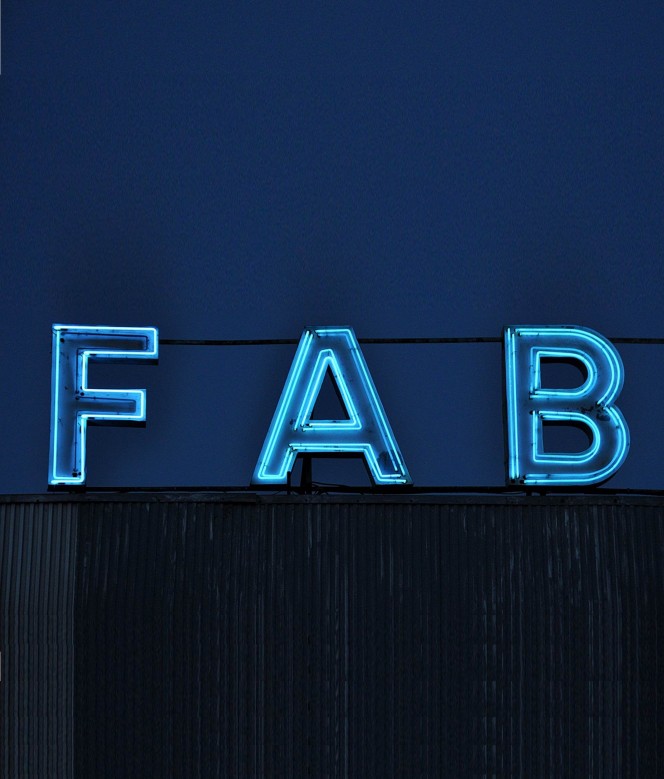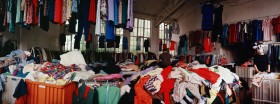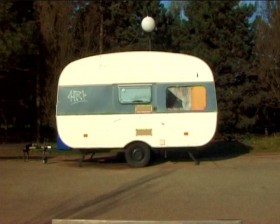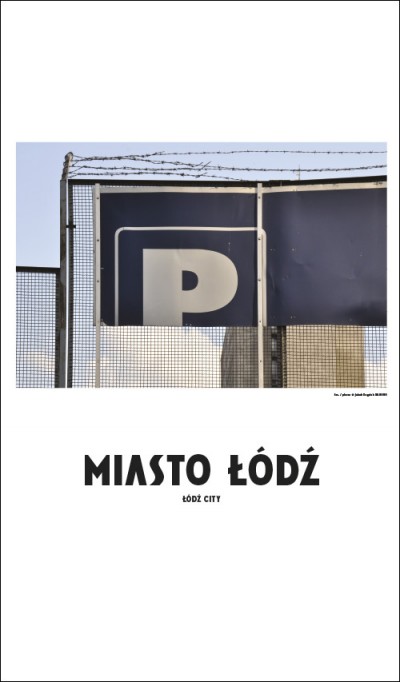Łódź City
31.07 – 03.10.2010 Łódź City
Kordegarda Project
artists: Sławomir Belina, Anna Orlikowska, Wunderteam (Wojciech Duda, Włodzimierz Filipek, Rafał Jakubowicz i Maciej Kurak), Monika Błażusiak, Balbina Bruszewska, Agnieszka Chojnacka, Artur Chrzanowski, Gregor Gonsior, Kamil Kuskowski, Monika Masłoń, Tomasz Matuszak, Modapolka.pl, Krzysztof Ostrowski, Jakub Stępień – HAKOBO, studenci PWSFiTV w Łodzi
curator: Magda Kardasz
ŁÓDŹ CITY/FAB
The exhibition owes its title to Jakub Stępień a.k.a. HAKOBO, its participant as well as author of its concept. HAKOBO has also designed the visuals for the show’s invitation and accompanying folder. The invitation is illustrated with a photograph showing a cropped image of the (broken?) neon sign of the local train station: ŁÓDŹ FAB[RYCZNA]. Describing the picture, HAKOBO used the dictionary definition of the informal British English adjective fab: ‘fab = the Fab Four = The Beatles’ and a translation into Polish of the adjective fabulous, which is ‘legendary’, and in the vernacular, ‘fantastic, exciting’. Hey, Jakub, you’re right to the point here!
Precisely this kind of fabulous Łódź – with its history, still to be clearly felt in the urban tissue, its social issues, a continuing modernization and commercialisation of public space, the unique Muzeum Sztuki and the avant-garde tradition, a history of famous projects organised by artists for artists, the world-renowned Łódź Film School (PWSFTViT), the Academy of Fine Arts (ASP) educating visual artists and fashion designers, or fi nally a vibrant music scene – was what I wanted to present at Kordegarda Project. The gallery space is small so a selection was necessary. Since I am not ‘from there’, I asked a couple of friends – HAKOBO, Kamil Kuskowski and Tomasz Matuszak at the ASP, curator Jolanta Ciesielska, a student friend and staff at the Film School – to help me. I am extremely grateful to them for their suggestions and assistance. There have been many ‘from Łódź’ exhibitions lately. What makes Łódź City special is that rather than focusing exclusively on the local visual arts scene, it puts the spotlight on young- and mediumgeneration artists and interesting phenomena in the fields of design, film, and music as well. All of the project’s participants share an affection for Łódź, a sensitivity to its issues, and the decision to pursue their professional careers there and not somewhere else. Łódź City is another Kordegarda/Kordegarda Project exhibition from the Room with a View series showing selected cities through artists’ eyes. Approaching the gallery, the viewer will see in its windows pictograms of various hand gestures. If they do not know sign language, they may feel intrigued by the cryptic message and, hopefully, keen to enter the gallery to solve the riddle. (The letters form the word Łódź). The project’s author is Tomasz Matuszak. He presented a similar project for the first time in the Israeli-Palestinian border zone in Haifa at the turn of 2000/2001, entitled Matrimony, as a sort of mediation effort between the feuding sides. In 2004, he showed another version in the windows of Łódź’s Café Europa, a soc-modernist pavilion proudly aspiring to being European. In Warsaw, the artist is showing the project’s third version, this time designed as a pseudo-advertising teaser of the city or exhibition.
An ugly-romantic, fantastic, Łódź is shown in City Slideshow, a 2006 work by Monika Masłoń. Andrzej Chrzanowski presents works showing the city in a state of flux, undergoing chaotic revitalisation, aspiring to the role of a modern metropolis. A work by Monika Błażusiak, visual artist and talented fashion designer, depicts the present-day ‘restored’ Łódź. The author has created a constructivist/abstract portrait of Manufaktura, the huge shopping mall converted from former factory that serves as the local centre of commercial/social life. Błażusiak also presents intriguing textiles with ‘views of Łódź’, an allusion to the city’s textile-industry traditions.
Agnieszka Chojnacka shows two works: Everything Will Be Alright (2006) and News (2007). The former, like the abovementioned one, tackles the theme of Łódź as a post-industrial city but does so in a socially committed manner. Łódź is a city of women – the (ex-)textile workers but also creative women, artists, a trail originally blazed by the great Katarzyna Kobro. Chojnacka’s multimedia installation tells the stories of the disappointed, but also of the hopeful and optimistic despite the hardships of daily life. News imitate the layout of a popular newspaper to ironically comment on the hyper-optimism of the contemporary mass media regarding the bright future all of us (including the inhabitants of Łódź) are facing. The work can also be interpreted as an attempt to reverse the dominant trend of playing up the violent and sensational on behalf of an optimistic ‘Everything will be alright’. Talking about inconvenient history is Kamil Kuskowski’s mural Anti-Semitism Repressed, created using a special kind of found objects – anti-Semitic graffi ti that can be found on the walls in various Polish cities. In Łódź, such graffi ti are a frequent feature of the verbal war between the fans of Widzew and ŁKS, the city’s two leading football clubs. Although painted over, the inscriptions still show through…
Sławomir Belina and Anna Orlikowska use Łódź, its picturesque-eclectic palace interiors and squalid outdoors, as a point of departure for spinning abstract tales. At end-2009, following several years of inactivity, Belina returned to the scene with a video installation called Norma, commissioned by the city’s leading arts patron, the Atlas Sztuki gallery. The Kordegarda Project exhibition features four parts of the project, shot in the historical interiors of the palaces of the city’s former industry tycoons. In each part, bizarrely dressed creatures perform strange activities and gestures. The campy costumes were created by Łódź-based tailors working under the artist’s supervision. A leading figure on Łódź’s artistic/social scene in the 1990s, based in Warsaw for many years now, Belina returns to the art world with this project.
Anna Orlikowska’s Us is a filmic story about parallel universes, skilfully utilising the city’s often gloomy sceneries as background for metaphysical stories.
Jakub HAKOBO Stępień, graphic and industrial designer and an expert on the city, has selected from his very rich oeuvre works related to Łódź. We will see drawings of buildings, a football fan’s-type scarf listing the city’s name in the languages of the four cultures that had originally created it, and a map presenting the city’s tourist attractions, both the classic ones and the less obvious ones (in association with Bęc Zmiana Foundation).
Wunderteam.pl are two designers, Paulina Stępień and Magdalena Koziej. At Kordegarda Project, they are showing an interior design project for the café at the Muzeum Sztuki building (ms Café) and other works related to the city. Modapolka.pl is a brand for clothes designed by Paulina Stępień and aimed at young female urbanites. Some of the actual clothes are presented in the show.
Gregor Gonsior combines fashion design with street art and mural painting. Examples of the various artistic disciplines he practices are featured in Łódź City. One of the gallery’s spaces has been turned into a screening room for the show’s duration. Comfortably seated, viewers can watch a selection, prepared in association with the Łódź Film School, of short student films set in Łódź. All coming from recent years, the etudes show the city today, its landscapes and various issues.
The city’s visual portrait is accompanied by music projects: Łódź-set music videos by Balbina Bruszewska (e.g. for Who If Not You by the fabulous hip hop artist O.S.T.R.). The City Flows, a full-feature animated film from which material for the video has been sampled, is shown too.
The exhibition opening featured a live performance by two leading representatives of the Łódź electronic music scene, Capitan Commodore and SLG.
We do hope that the Kordegarda Project exhibition encourages viewers to visit the FABULOUS ŁÓDŹ CITY.



